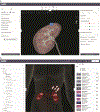Anatomical structures, cell types and biomarkers of the Human Reference Atlas
- PMID: 34750582
- PMCID: PMC10079270
- DOI: 10.1038/s41556-021-00788-6
Anatomical structures, cell types and biomarkers of the Human Reference Atlas
Abstract
The Human Reference Atlas (HRA) aims to map all of the cells of the human body to advance biomedical research and clinical practice. This Perspective presents collaborative work by members of 16 international consortia on two essential and interlinked parts of the HRA: (1) three-dimensional representations of anatomy that are linked to (2) tables that name and interlink major anatomical structures, cell types, plus biomarkers (ASCT+B). We discuss four examples that demonstrate the practical utility of the HRA.
© 2021. Springer Nature Limited.
Figures




References
-
- International Human Genome Sequencing (IHGS) Consortium Initial sequencing and analysis of the human genome. Nature 409, 860–921 (2001). - PubMed
-
- Venter JC et al. The sequence of the human genome. Science 291, 1304–1351 (2001). - PubMed
-
- Rozenblatt-Rosen O, Stubbington MJT, Regev A & Teichmann SA The Human Cell Atlas: from vision to reality. Nature 574, 187–192 (2017). - PubMed
Publication types
MeSH terms
Substances
Grants and funding
- R01 AR079233/AR/NIAMS NIH HHS/United States
- U54 DK120058/DK/NIDDK NIH HHS/United States
- U54 AR081775/AR/NIAMS NIH HHS/United States
- U54 HL145611/HL/NHLBI NIH HHS/United States
- U54 HL145608/HL/NHLBI NIH HHS/United States
- R01 LM012832/LM/NLM NIH HHS/United States
- U01 DK107350/DK/NIDDK NIH HHS/United States
- UG3 HL145609/HL/NHLBI NIH HHS/United States
- UH3 DK114933/DK/NIDDK NIH HHS/United States
- UH3 CA246594/CA/NCI NIH HHS/United States
- U54 AI142766/AI/NIAID NIH HHS/United States
- UG3 CA256960/CA/NCI NIH HHS/United States
- OT2 OD026671/OD/NIH HHS/United States
- U24 DK110814/DK/NIDDK NIH HHS/United States
LinkOut - more resources
Full Text Sources

